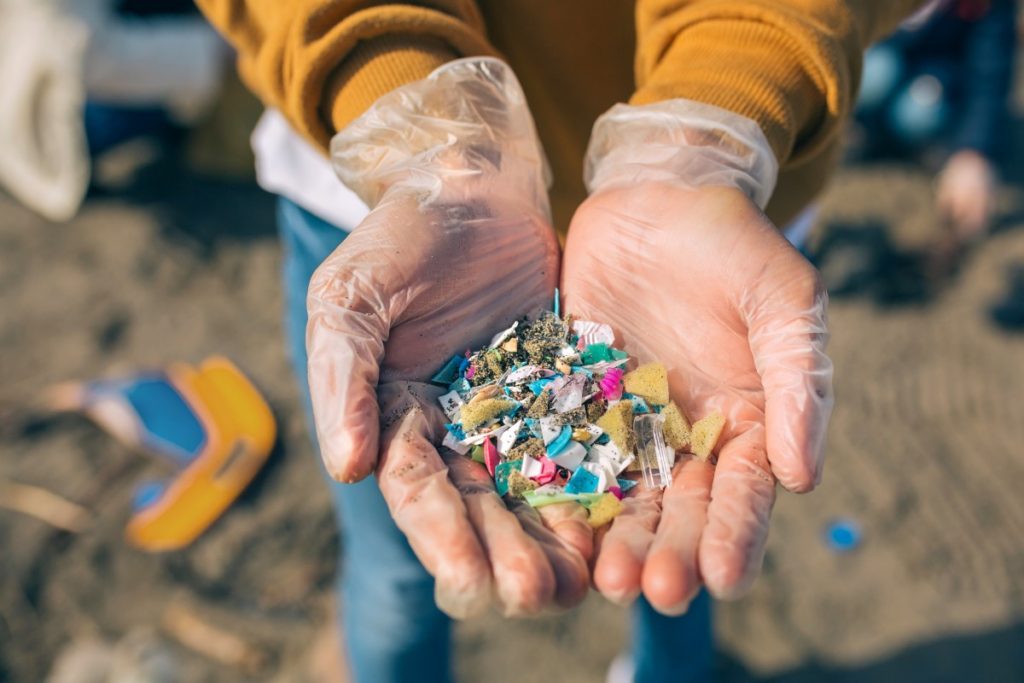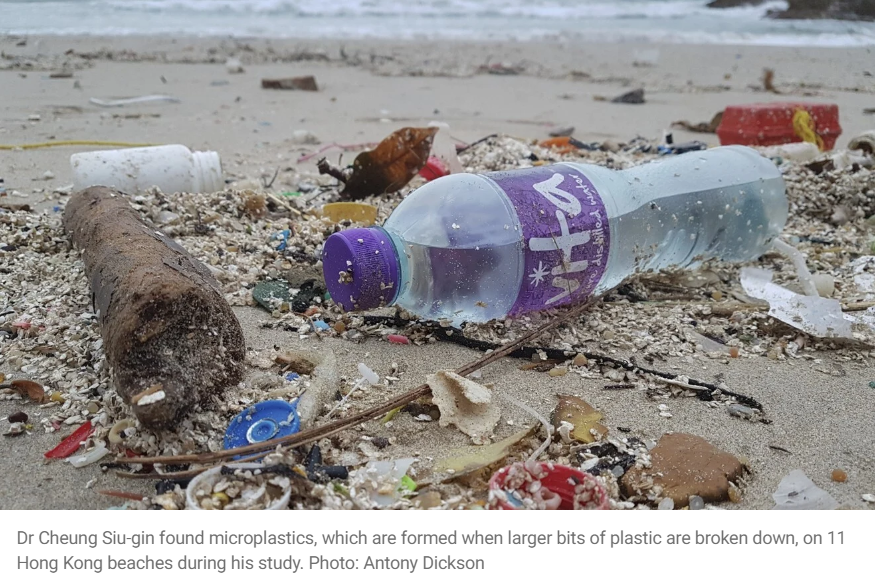- City University associate professor Dr Cheung Siu-gin makes discovery while collecting fragments for other research
- WWF-Hong Kong researcher says results show just how big the plastics problem is

Detail of hands showing microplastics on the beach. Photo: Shutterstock
Sea animals could be chewing on ocean plastic waste and creating microplastics at a faster rate than previously thought, a Hong Kong researcher has found.
Dr Cheung Siu-gin, an associate professor at City University, made the discovery as he was collecting the tiny plastic fragments for other research, and noticed about 10 per cent of the microplastic gathered from Hong Kong’s mudflats and beaches were neat triangles.
“Some were shaped like sandwiches. I didn’t think it was possible they could have disintegrated naturally,” Cheung said. “So it seems likely that fish or other sea animals are eating plastic waste.”
His finding could mean larger ocean plastics are being broken down into microplastic faster than previously thought. The study, which has been published in the scientific journal Marine Pollution Bulletin, is one of the first in the world to categorise such microplastics.

Microplastics are usually formed when larger pieces of plastic waste in the ocean are broken up over time by the waves or heat from the sun, resulting in irregularly shaped fragments, while man-made microplastics used in personal care products were usually small beads, Cheung said.
The United States National Oceanic and Atmospheric Administration (NOAA) defines microplastics as any type of plastic fragment less than 5 millimetres in length. The small plastic fragments are a huge problem for marine environments, as they can be eaten by many types of sea creatures, which can lead to a variety of issues, including stunted growth.
The fragments Cheung collected have an average size of 4.17 square millimetres, and were found on 11 beaches across Hong Kong, including Cheung Chau and Stanley Bay.
“These findings have confirmed something most ocean plastics researchers have been speculating,” said June Wong So-kwan, lead researcher for the marine plastics programme at WWF-Hong Kong. “It shows just how big a problem plastic is.”
Wong said because of the minuscule size of microplastics, they are too difficult to clean up from beaches, meaning they stay in the ecosystem for longer and release toxic chemicals into the environment.
Cheung compared the fragments to the bite marks of pufferfish, which have similarly shaped beaklike front teeth, but he did not find any plastic fragments in the guts of pufferfish.
He said that could be because a pufferfish spits out things it does not want to swallow.
The associate professor concluded other types of fish could also be trying to eat plastic, which becomes coated with a layer of microorganisms called a biofilm within days of entering the water.
Sea animals, including sea turtles, are attracted by the scent of the biofilm and try to eat plastic waste, Cheung said.
He has since been placing camera traps near pieces of plastic waste tied down on racks in an attempt to catch animals in the act, but has yet to have any luck.
Cheung, who has studied microplastics for five years, said he has also seen pieces of plastic during beach cleanups that have triangular holes in them, which further strengthens his belief in his theory.
“I don’t think anyone would go through the trouble of making those holes,” he said.
Wong said she had also made a similar observation.
Scientists estimate up to 8 million tonnes of plastic enters the world’s seas and oceans every year.
The Environmental Protection Department said it had been trying to prevent plastics from entering the ocean, by aiming to reduce plastic production, reducing the amount of plastic falling into the sea, and increasing its clean up of the ocean.
It said it was reviewing the city’s plastic bag charge, while the public consultation for a producer-pays scheme for plastic bottles was expected this year. It has also invested HK$150 million into beach clean up and patrol effort
Edwin Lau Che-feng, the executive director of local environmental group The Green Earth, said the Hong Kong government should be doing more to educate residents about how plastic ends up in the sea.
“Some people think that litter in cities does not end up in the ocean, but that’s not true,” he said. “It enters the drainage system and then washes directly into the sea.”
Wong said it would take all sectors, including individuals, governments, and corporations working together to reduce plastic at the source to be able to solve the problem.
“There’s no silver bullet. If we do not stop using and making plastic, we can keep trying to collect all the waste but it would be pointless.”
Article Credit: scmp
